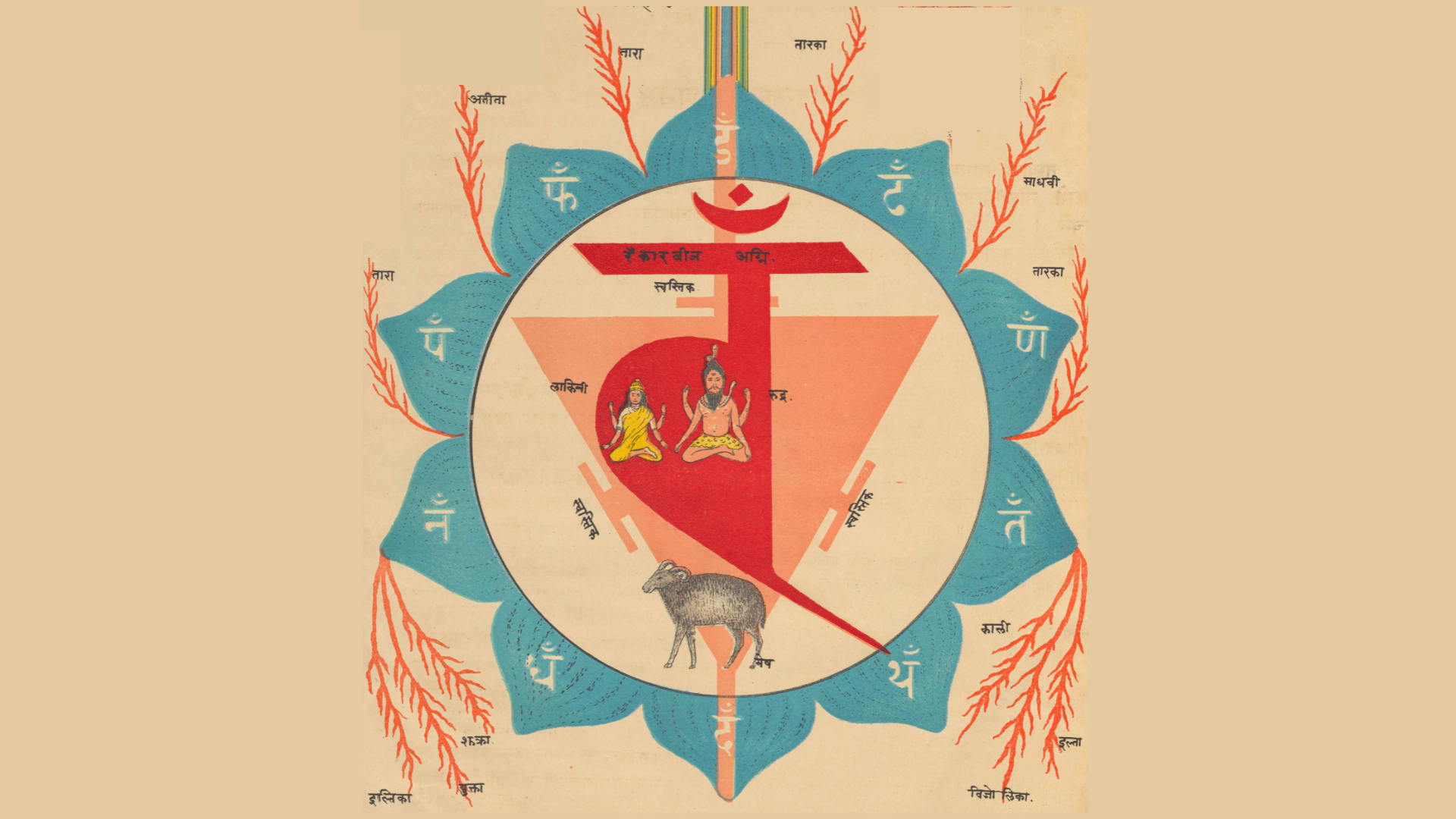Manipura Chakra: Seat of nourishment and ambition
By Devendra Narayan, PhD.

Credit: MS Sanskrit 391. Authored by Svami Hamsasvarupa, 1900s. Wellcome Collection. The original image has been modified for use in this article.
- Manipura is the ten-petalled, cloud blue-colored lotus (chakra) located at the base of the navel.
- The masculine and feminine deities residing within the manipura chakra are Rudra and Lakini.
- Manipura chakra is associated with the fire element and is seen as the center for nourishment and ambition.
My previous articles discussed the architecture of the muladhara and svadhisthana chakras as portrayed in the 16th century text Sat Chakra Nirupana. This article continues our journey through the inner pilgrimage as we explore the architecture of the third sacred city, the Manipuraka chakra, also called Manipura chakra.
Manipura Chakra
The Manipura chakra is located at the base of the navel above the Svadhisthana chakra. It has ten petals and shines like a rain cloud.
Associated with each petal is a unique sound. The corresponding letter is adorned on the petal. The sounds are dam, dham, nam, tam, tham, dam, dham, nam, pam, and pham.
The Manipura chakra contains a triangular yantra that is sacred to the god of fire (VaizvAnara). Visualize it in red like the morning sun as you meditate on this Yantra. On each face of the triangle yantra is a door known as Swastika.
The triangular yantra contains the bija mantra of fire, ram (propounded rum), riding a ram (animal). It should also be meditated upon in a red hue, similar to the morning sun.

Credit: MS Sanskrit 391. Authored by Svami Hamsasvarupa, 1900s. Wellcome Collection. The original image has been modified for use in this article.
The masculine deity residing within the Manipura chakra is Rudra (the fierce form of Shiva). Shining in a vermilion red color with three eyes and four arms, body covered in ash and adorned with ornaments. Creating a mudra in each pair of hands to symbolize 1) fulfilling the desires of his devotees with the varada mudra, and
2) assuring their safety with the abhaya mudra.
Near Rudra is Devi Lakini who bestows good on all. Having four arms and shining dark skin, Lakini wears yellow garments and is adorned with ornaments. Sat Chakra Nirupana depicts her in an ecstatic state of mind (mattachitta).
I find it interesting that in the previous two chakras, Muladhara and Svadhisthana the female deity (Devi) was to the left of the male deity (Deva). In the depiction of the deities for the Manipura chakra, we see that Devi Lakini is to the right of Rudra. What is the significance of this? It is unclear to me. Nonetheless, it is worth considering during chakra meditation.
Note, too, that images featuring hue-colored chakras show the Manipura chakra in a yellow hue. However, the original Sanskrit verse in Sat Chakra Nirupana specifies that cloud blue is the color of Manipura chakra.
Those who meditate on the Manipura chakra are said to possess complete control over speech (vani) as the goddess of speech herself resides at the tip of their tongue.
In the next article, we will describe the architecture of Anahata chakra, the fourth of the seven inner sacred cities.
About the Author
Devendra Narayan is a scientist, yoga teacher, breathworker, scholar and founder of Cultivate Prana Academy. Cultivate Prana's mission is to empower modern day healers through education that integrates ancient wisdom and modern science.
Reference:
Svāmihaṃsasvarūpakr̥tam Ṣaṭcakranirūpaṇacitram : bhāṣyasamalaṃkr̥taṃ bhāṣāṭīkopetañ ca = Shatchakra niroopana chittra with bhashya and bhasha containing the pictures of the different nerves and plexuses of the human body with their full description showing the easiest method how to practise pranayam by the mental suspension of breath through meditation only ; by Shri Swami Hansa Swaroop.
-------
Copyright 2021 Cultivate Prana. All rights reserved.

